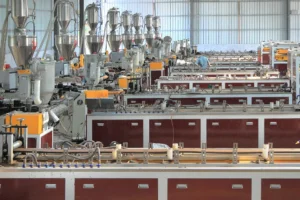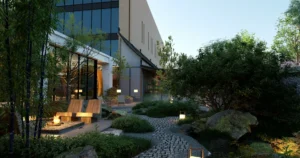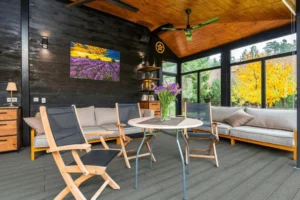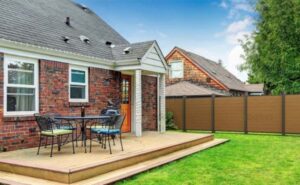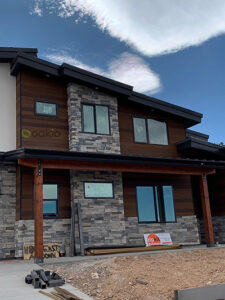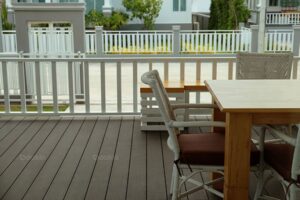4 Best Deck Material Options in 2024
Choosing the right deck material is important since the deck may accompany you for decades. The right deck material can not only help you build a wonderful indoor and outdoor space but also provide you with an immersive oasis.
The common deck material options on the market include traditional wood, pressure-treated wood, composite (WPC), and PVC.
In this article, we will explain their pros and cons so you can see which material option suits your expectations best.
Traditional Wood Decks
Traditional wood decks are adorned by many homeowners and designers due to their natural aesthetic. Here are two types of traditional wood decks on the market: hardwood decks and softwood decks.
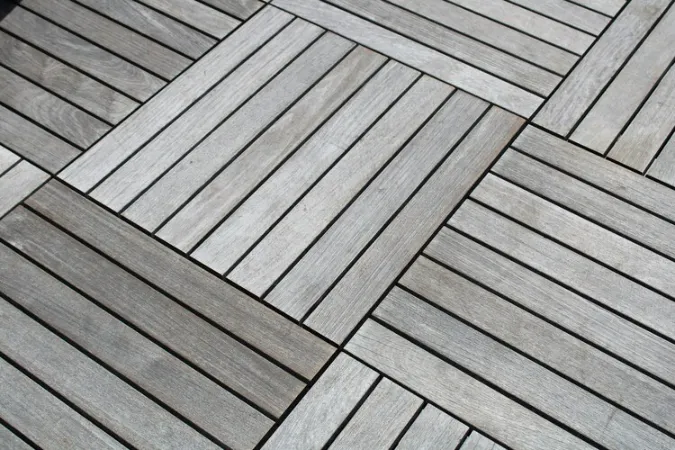
A. Hardwood Decks
Hardwoods are usually derived from broadleaf trees, such as oak, maple and mahogany.
– Pros: Durability & Aesthetic
Hardwood decks typically have tight wood grain and high compressive strength, giving them great strength and durability. Additionally, hardwoods often have intricate and beautiful wood grains, which makes them very popular in high-end furniture and flooring.
– Cons: High Maintenance & High Cost
Hardwood decks are highly durable, but they also require regular maintenance to prevent rot and insect infestation. For example, Ipe, a very durable, still requires regular care to maintain its color and structure when used outdoors. Typically, they require sanding and re-staining every 2-5 years, and re-sealing every 1-3 years.
The upfront and maintenance costs of hardwood decks are also relatively high. Hardwoods are generally more expensive than softwoods due to their rarity and superior properties.
B. Softwood Decks
Softwoods usually come from conifers or evergreen trees, such as pine, cedar and fir.
– Pros: Cheaper & Aesthetic
Softwood decks are often used in construction and structural materials due to their high accessibility and lower cost. Even though softwoods have a looser wood grain, they still possess natural aesthetic.
– Cons: High Maintenance & Less Durable
Softwoods decks are less dense and less hard, and have a looser grain. This makes softwoods easier to work with, but also means they are not as durable as hardwoods. Besides, softwood decks are more susceptible to weathering and requires more maintenance and more frequent replacement.
Pressure-Treated Wood Decks
Pressure-treated wood is wood that has undergone a special treatment process to enhance its durability. In this process, preservatives are injected into the wood’s structure under high pressure, allowing the preservatives to deeply penetrate and bond with the wood fibers.
– Pros: Lower Cost & High Resistance
Compared to some naturally durable wood decks(such as redwood or cedar), pressure-treated wood decks are generally more cost-effective. Due to the deep penetration of preservatives, pressure-treated wood decks have enhanced resistance to decay and insects, making them suitable for outdoor use.
– Cons: Toxic & High Maintenance
However, due to the use of chemical preservatives, pressure-treated wood decks may have some chemical residues, posing potential risks to the environment and human health. Additionally, the maintenance costs for pressure-treated wood decks are high. Although they are more durable, regular maintenance, such as applying waterproofing agents or protective coatings, is still necessary to extend its lifespan. Treated wood may also fade in sunlight, gradually turning gray, and thus requires periodic staining or coloring to maintain its appearance.
Composite Decks
Composite decks (WPC decks) Are a type of synthetic decking material made from a blend of wood fibers and plastic (often recycled plastic). This material combines the natural aesthetics of wood with the durability of plastic.
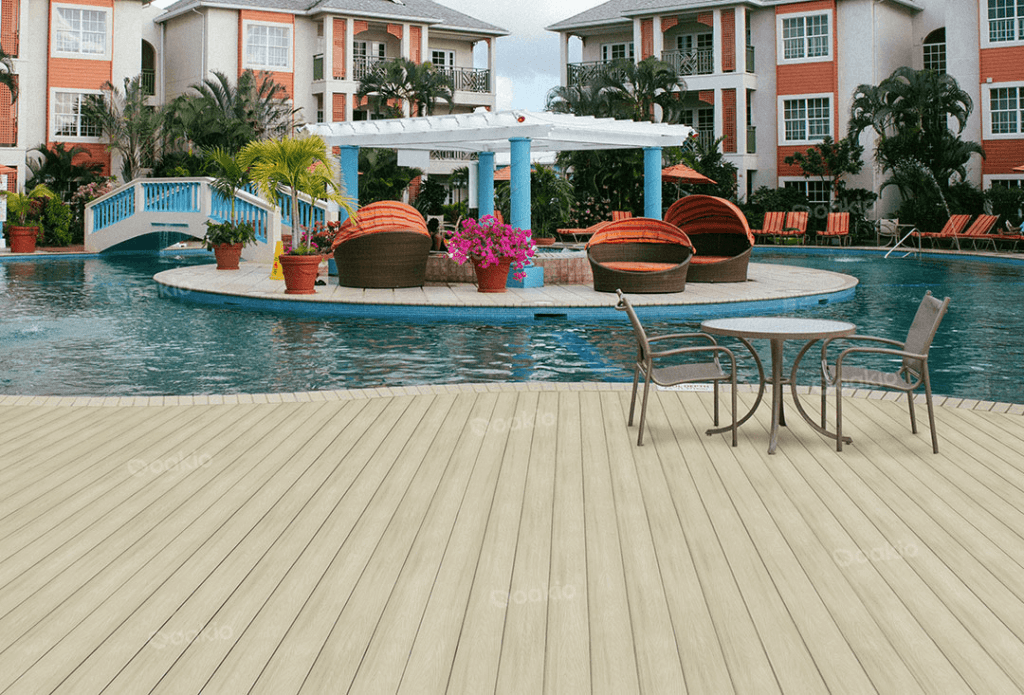
– Pros: Low maintenance & High performance
Composite decks are highly favored for their low maintenance requirements and superior performance. Unlike traditional wood decks, composite decks do not need regular staining, sealing, or sanding to maintain their appearance and structural integrity. They are resistant to fading, warping, and cracking, making them durable in various weather conditions. Composite decks are also available in a wide range of colors and textures, offering versatility in design options.
– Cons: Cost
One of the main drawbacks of composite decks is their higher initial cost compared to traditional wood decks. The materials used in composite decking, which include recycled plastics and wood fibers, contribute to its durability but also increase production costs. Additionally, the price of composite decking can vary widely depending on the brand and features, such as capped or uncapped boards.
PVC Decks
PVC decks typically use polyvinyl chloride (PVC) resin as the primary material. The process involves mixing the resin with additives to create a plastic compound, which is then extruded or pressed into deck shapes. Finally, colors, textures, and protective layers are added as needed to enhance durability and visual appeal.
– Pros: Low maintenance & Durability
PVC decks are renowned for their exceptional durability and minimal maintenance requirements. They resist moisture, mold, and insect damage effectively due to their synthetic composition, making them highly durable in various weather conditions. This resilience and longevity, combined with the fact that PVC decks do not require regular staining, sealing, or painting, simplifies upkeep with easy cleaning using soap and water, offering homeowners hassle-free outdoor living spaces.
– Cons: Cost & Environmentally damaging
PVC decks, while durable and low maintenance, come with a higher upfront cost due to the materials and manufacturing processes involved. Additionally, they raise environmental concerns related to energy-intensive production, chemical additives, non-biodegradability, and recycling challenges.
How To Choose the Best Deck Material
Choosing the best deck material involves evaluating key factors:
- Desired Look and Feel:
Decide between natural wood’s aesthetic and the modern appeal of synthetic options like composite or PVC. - Usage and Location:
Consider if the deck will be installed near water or in a humid climate, requiring materials resistant to moisture and mold. - Maintenance:
Assess your willingness for upkeep; natural wood needs regular maintenance, while composite and PVC are low maintenance. - Budget:
Factor in upfront costs and long-term expenses; hardwood decks are typically pricier initially, with higher maintenance costs.
Use a decision matrix to compare materials based on these criteria to ensure your choice meets both practical needs and personal preferences.
Here is a deck material options comparison table:
| Deck Material | Maintenance | Durability | Cost | Suitability |
| Hardwood Decks | High | High | High | Suitable for various environments |
| Softwood Decks | High | Moderate | Moderate to Low | Best in drier climates |
| Pressure-Treated Wood Decks | Moderate | Moderate to High | Moderate to Low | Good for humid environments |
| Composite Decks | Low | High | High | Great for all environments |
| PVC Decks | Very Low | Very High | High | Excellent for humid and coastal areas |
Conclusion
Balancing aesthetics, performance, and budget is crucial when choosing the best deck material. For those prioritizing low maintenance and durability, composite and PVC decks are excellent choices. Natural wood decks offer timeless beauty but require more upkeep. Pressure-treated wood provides a cost-effective option, especially for those on a tighter budget. By evaluating your specific needs and preferences, you can select a deck material that enhances your outdoor space and meets your long-term expectations.
Consider the insights from this guide to make an informed decision about your deck material. Explore specific brands and products to find the perfect match for your needs. If you are considering composite decks, Oakio’s Proshield composite decks can be a great choice.
Trending Reading
What Are the Differences Between the WPC Board and PVC Board?
[2024 Update] How Long Does WPC Decking Last?

